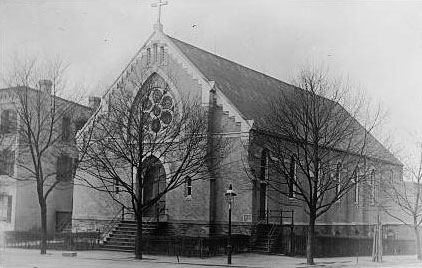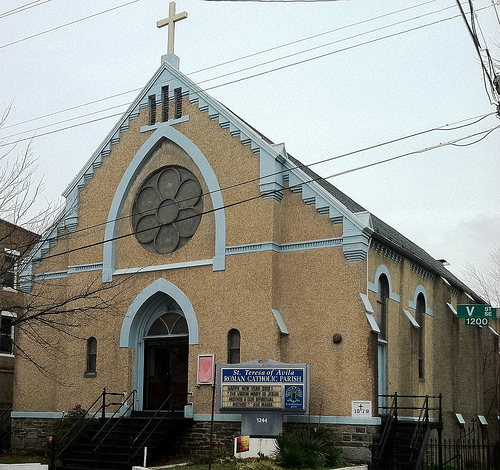Then & Now: Anacostia’s Saint Teresa
As songs of praise emanate from numerous houses of worship in Anacostia each Sunday morning, one church stands out as a part of living history. It has experienced reorganization, schisms, and change, but it still faithfully anchors the same corner as it did more than 130 years ago.
Saint Teresa of Avilla Avila, at the northwest corner of 13th and V streets SE, is the oldest Roman Catholic Church in DC east of the Anacostia River. It was originally part of the Archdiocese of Baltimore, because the Vatican did not make the City of Washington a separate archdiocese until 1939. St. Teresa, in fact, is older than the Archdiocese of Washington by more than a half century.
The new church was greeted with great enthusiasm even before it was finished being built. An April 1879 Washington Post article describing the laying of its cornerstone also reports of a celebratory parade, saying:
The route was determined on as follows: from City hall, down Four-and-a-half street to Pennsylvania avenue, thence to St. Peter’s church, where the visiting clergy and others will join the procession, thence across the navy yard bridge to Uniontown. With regard to the formation of the line, it is thought that it will be the same on St. Patrick’s day, except that there will be five divisions instead of four, the colored societies making the fifth.
When Saint Teresa opened its doors in the fall of 1879 Uniontown had a hotel, post office, police substation with mounted patrols while Henry A. Griswold’s single-horse streetcar ran every 20 minutes. Frederick Douglass, the United States Marshal for the city lived just down the street.
According to The Anacostia Story. by the turn of the 20th century black parishioners were dissatisfied with the limited role they were permitted; African Americans were relegated to celebrate Mass in the church basement.
In response a group under the name “Mission of St. Teresa” organized to establish a separate church and parish for African American Catholics. Others changed their affiliation and went crosstown to Saint Augustine, the city’s mother church for black Catholics since 1858, four years before the city’s emancipation.
By 1920 ground was dug, dirt was moved, cement was turned and cornerstone laid for Our Lady of Perpetual Help Church on Morris Road SE, on the grounds of Fort Stanton.
According to Cultural Tourism DC, this was the second formal division of St. Teresa’s. The first occurred when white parishioners left to establish Assumption Catholic Church in what had been the village hall for Congress Heights at 611 Alabama Avenue SE on April 2, 1916.
As the neighborhood’s demographics began to change in the 1960s and the neighborhood became increasingly African American, the congregation of Saint Teresa changed as well. In 1976 Saint Teresa received its first African-American pastor. On a recent visit, with the exception of some college students, the overwhelming majority of worshipers are African American.
Today, Saint Teresa is one of more than a dozen historic churches in greater Anacostia still going strong, an important and familiar neighbor for parts of three centuries.
Excerpts from this post originally appeared in a 2010 article for East of the River.


